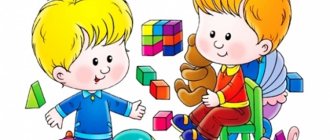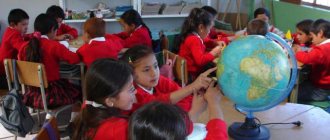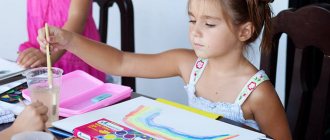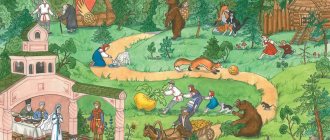Social and personal development
Social and personal development is the process and result of two interconnected and interdependent processes: socialization and interiorization, which are aimed at the child’s entry into the sociocultural environment.
Interiorization is a process as a result of which a child acquires new personality traits, drawing them from social reality, the process of becoming social into individual (L.S. Vygotsky).
Currently, special attention is paid to the problem of social and personal development and education of preschool children, which is one of the components of the draft State Standard for Preschool Education. Increased attention to the problems of socialization is associated with changes in socio-political and socio-economic living conditions, with instability in society. In the current situation of an acute lack of culture of communication, kindness and attention to each other, teachers experience difficulties in preventing and correcting such negative manifestations of children as rudeness, emotional deafness, hostility, etc. The need for a detailed and in-depth study of the problem is also dictated by the established practice of preschool educational institutions and the relevance of developing programs and methods for using modern technologies for the social and personal development of preschool children.
The problem of inclusion in the social world has always been and now remains one of the leading ones in the process of forming a child’s personality. Historical analysis convinces of the need to provide a child with qualified assistance in the complex process of entering the human world. The socialization of a preschooler involves the development of the ability to adequately navigate the social environment available to him, to realize the intrinsic value of his own personality and other people, to express feelings and attitudes towards the world in accordance with the cultural traditions of society.
The draft standard for preschool education, defining the mandatory minimum content of the program implemented in a preschool educational institution, puts forward a number of requirements for the social and personal development of its pupils. These requirements include:
— development of a child’s positive attitude towards himself, other people, the world around him, children’s communicative and social competence;
- creating conditions for the child to develop a positive sense of self - confidence in his abilities, that he is good, that he is loved;
- formation in the child of self-esteem, awareness of his rights and freedoms (the right to have his own opinion, choose friends, toys, activities, have personal belongings, use personal time at his own discretion);
- nurturing a child’s positive attitude towards people around him - respect and tolerance for children and adults, regardless of social origin, race and nationality, language, religion, gender, age, personal and behavioral identity, respect for the self-esteem of other people, their opinions, desires, views;
- introducing children to the values of cooperation with other people: providing assistance in recognizing the need of people for each other, planning joint work, subordination and control of their desires, coordinating opinions and actions with partners in activities;
- developing in children a sense of responsibility for another person, a common cause, a given word;
- creating the child’s communicative competence - recognizing the emotional experiences and states of others, expressing one’s own experiences;
- developing social skills in children: mastering various ways to resolve conflict situations, the ability to negotiate, take turns, and establish new contacts.
A large role in the successful social and personal development of preschoolers is played by a team of like-minded people, which is formed from the kindergarten administration, teachers, educational psychologist, physical education instructor, and music directors. Educators form children's ideas about the social world, about themselves, the people around them, nature and the man-made world, and cultivate social feelings and an active life position. Musical directors help in creating dramatizations, playing out situations using scenery and costumes. A teacher-psychologist works with children to master the language of emotions and correct aggressiveness; formation of self-confidence, social skills, moral consciousness.
In order to ensure social partnership between the preschool educational institution and the family, it is necessary to pay great attention to working with parents. To ensure close interaction between teachers and parents in the social and personal direction of working with children, it is necessary to draw up a plan for working with parents in this direction, and to familiarize parents with the work of the kindergarten, use parent meetings, consultations, open classes, joint holidays, registration in the “Parents Corner” " and etc.
Communication with peers
In preschool age, communication with peers differs from communication with adults and has a number of features:
- Extreme emotional intensity and relaxed contacts with peers. On average, 9-10 times more emotional manifestations are observed in interactions with peers than with adults. Conversations with other children are often accompanied by harsh intonations, screaming, laughter, and conflict situations occur more often. When communicating with peers, a child can impose his will, calm, demand, deceive, and so on. Here, for the first time, complex forms of behavior such as pretense, expression of resentment, coquetry, fantasizing, etc. appear.
- Non-standard and unpredictability. When interacting with peers, a child is characterized by a special looseness; he uses the most unexpected and original actions and movements: jumps, takes bizarre poses, makes faces, squeals, imitates, etc. If an adult provides behavioral models for the child, then the peer creates conditions for individual, non-standard manifestations, helping to express yourself and your creativity.
- The predominance of proactive actions over reactive ones. For a preschooler, his own statement or action is much more important, while his peer’s initiative is supported much less often and is sometimes ignored. For this reason, children often have conflicts and resentments.
Communication with peers also goes through a number of stages:
- Emotional-practical communication (2–4 years). At this stage, it is most important to express yourself, to gain attention and complicity from the other child. At the same time, the child himself does not notice the desires and feelings of his friend. Interaction and joint games are external in nature: children run after each other, hide, scream, make faces, act by repeating simple actions: “you jump - I jump”, “you scream - I scream.” The child needs a peer to join in his actions and pranks, support and enhance the overall fun. Such communication is necessarily situational and depends on the specific situation. An attractive object can easily occupy children's attention and stop their communication. They don’t know how to play with the same toy together, and because of this they often conflict. The affirmation and defense of one’s “I” comes first of all through the demonstration of one’s own toys and objects - “This is mine!”
- Situational business communication (5–6 years). Preschoolers are busy with a common cause; they must coordinate their actions and take into account the behavior of their partner to achieve a common result. The need for cooperation with a peer, his recognition and respect becomes paramount. This is realized primarily in the game. There is also a keen interest in everything that a peer does. A child can demonstrate his advantages and achievements, but try to hide his mistakes and failures. A competitive element appears in communication, and the number of conflicts increases significantly. Envy, jealousy and boasting arise. The child begins to evaluate by comparison with other children.
- Non-situational business communication (6–7 years). During this period, “pure communication” not related to the game becomes possible. But sometimes it can take place in the background of a game or other activity. Children can talk to each other on abstract topics, talk about where they have been, what they have seen, share desires, interests, discuss other people, etc. A personal attitude towards a peer is born - emotional involvement in his experiences, the ability to see his moods, desires and preferences in his partner; there is an opportunity to reach a compromise in a dispute. By the end of preschool age, the game changes, and interaction increasingly occurs at the level of real relationships (discussion of rules and preparation for the game) and less and less at the level of role positions.
Friendship is formed. Preschoolers can create small groups (2-3 people each) and give preference to peers close to themselves. Disputes and conflict situations may arise based on “who is friends with whom.” The child’s emotional well-being depends on his position in the peer group, which determines how much he learns the norms of relationships with other people. Therefore, it is very important for a child to communicate with children of his own age and the ability to build joint play, contact and dialogue with them.
We talk more about how to develop a child’s social communication in the article Principles of effective development of a preschooler.
Means, methods, techniques for the social and personal development of children in preschool educational institutions
The implementation of the tasks of social development of preschool children is most effective in the presence of an integral pedagogical system, built in accordance with the basic approaches of the general scientific level of pedagogical methodology.
· The axeological approach allows us to determine a set of priority values in education, upbringing and self-development of a person. In relation to the social development of preschool children, these can be the values of communicative, psychosexual, national, ethnic, and legal culture.
· The cultural approach allows one to take into account all the conditions of the place and time in which a person was born and lives, the specifics of his immediate environment and the historical past of his country, city, and the basic value orientations of representatives of his people and ethnic group. The dialogue of cultures, which is one of the dominant paradigms of the modern education system, is impossible without familiarization with the values of one’s culture.
· The humanistic approach presupposes recognition of the personal beginning in the child, orientation towards his subjective needs and interests, recognition of his rights and freedoms, the intrinsic value of childhood as the basis of mental development, the cultural creative function of childhood as one of the most important aspects of social development, psychological comfort and the welfare of the child as priority criteria in assessing the activities of social institutions.
· The anthropological approach makes it possible to increase the status of psychological and pedagogical diagnostics in determining the dynamics of social development of preschool children, to take into account various (age, gender, national) features of personal development in the process of moral, sexual, patriotic, international, and legal education.
· The synergetic approach allows us to consider each subject of the pedagogical process (children, teachers, parents) as self-developing subsystems that make the transition from development to self-development. In terms of the social development of children, this approach provides, for example, a gradual change in the general orientations of the teacher in the formation of basic types of activity (from perception - to reproduction according to a model - to independent reproduction - to creativity).
· The multi-subject approach presupposes the need to take into account the influence of all factors of social development (microfactors: family, peers, kindergarten, school, etc.; mesofactors: ethnocultural conditions, climate; macrofactors: society, state, planet, space).
· The systemic-structural approach involves organizing work on the social development of preschool children in accordance with an integral pedagogical system of interrelated and interdependent goals, objectives, content, means, methods, forms of organization, conditions and results of interaction between teachers and children.
· An integrated approach involves the interconnection of all structural components of the pedagogical system in relation to all links and participants in the pedagogical process. The content of social development includes the child’s orientation in the phenomena of social and personal life, in himself.
· The activity approach allows us to determine the dominant relationship between the child and the outside world, to actualize the fulfillment of the needs for self-awareness as a subject of activity. Social development is carried out in the process of significant, motivated types of activity, a special place among which is occupied by play, as an activity in itself that provides a feeling of freedom, subordination of things, actions, relationships, allowing one to most fully realize oneself “here and now”, achieve a state of emotional comfort, become involved in a children's society built on free communication of equals.
· The environmental approach allows us to solve the problem of organizing the educational space as a means of social development of the individual. The environment is a set of niches and elements, among which and in interaction with which children’s lives take place. A niche is a certain space of possibilities that allows children to satisfy their needs. Conventionally, they can be divided into natural, social, and cultural. In relation to the tasks of social development, the organization of educational space requires the creation of a subject-development environment that ensures the most effective introduction of children to the standards of culture (universal, traditional, regional). The element is an unconstrained force acting in the natural and social environment in the form of various social movements, manifested in moods, needs, and attitudes. In relation to the social development plan, the element will be found in the interaction between children and adults, in the dominant value orientations, in the hierarchy of goals in relation to the ranking of educational tasks.
What is the social development of a preschooler?
The social development of a child is the assimilation of the traditions of society, culture, the environment in which the child grows, the formation of his values, and communication skills.
Even in infancy, the child establishes first contacts with the world around him. Over time, he learns to establish contacts with adults and trust them, control his body and actions, construct his speech and formulate it in words. To form a child’s harmonious social development, it is necessary to devote maximum time and attention to him and his curiosity. This is communication, explanations, reading, games, in a word, arming with maximum information about the human environment, rules and norms of communication, behavior.
At the first stage, the family is the main unit for the transfer of experience and knowledge accumulated earlier . To do this, the child’s parents and his grandparents are obliged to create an optimal psychological atmosphere in the house. This is an atmosphere of trust, kindness, mutual respect, which is called the primary social education of children.
Communication is a key factor in the social development of a child’s personality. Communication underlies the social hierarchy, which is manifested in the “child-parent” relationship. But the main thing in these relationships should be love, which begins from the mother’s womb. It is not for nothing that psychologists say that a desired child is a happy, self-confident and, in the future, successful person in society.
Practical situations of humanistic choice.
Preschoolers are faced with a choice : respond to the problems of other children or prefer personal interests and show indifference?
For example, keep the drawing for yourself or include it in a general message to a sick peer; respond to a request for help or ignore it?
The behavior of children in situations of choice helps to better understand the characteristics of their social, moral and emotional development.
2. Practical situations of a problematic nature such as “What to do, what to do?” personality behavior education preschool
These are various difficult situations that we create in order to awaken children’s initiative, independence, intelligence, responsiveness, and willingness to look for the right solutions.
Situations: there are no paints of certain colors, there is not enough plasticine for modeling. Children independently look for solutions and solve problems together.
3. Practical situations “We are the oldest in kindergarten .”
Children learn to take care of children, they develop a sense of self-esteem, a kind attitude towards little ones, and an understanding of their problems.
You can organize the situations “We will delight the kids with gifts made by ourselves”, “We will prepare a concert for the kids”, “We will show a fairy tale”, “We will help make a snow slide”, “We will teach the kids how to dance in circles”.
4. The following situations are like “We are friends with schoolchildren.”
Senior preschoolers gain experience in collaborating with school students: “We are having a sports festival,” “Joint literary quiz in the library,” “We are waiting for our teachers.”
Participation in such situations deepens interest in school and relieves anxiety associated with upcoming schooling. At the same time, valuable experience of inter-age communication is formed, which is important not only for preschoolers, but also for students.
5. Children are very fascinated by situations like “Teach your friend what you can do yourself.”
We encourage children to show attention to each other, mutual assistance and cooperation. Children share their experiences, we help them enter the role of “teacher”, i.e. be patient, attentive and forgiving to the mistakes and difficulties of peers.
6. Children also participate in imitation games : changing emotional and physical states, imitating states of nature, etc.
I would like to emphasize that our constant assistant in the social and personal development of children is the family . Only in cooperation with close adults can high educational results be achieved.
Interaction with family is effective provided there is trust in each other, understanding and acceptance of common goals, methods and means of social and personal development.
It is necessary to instill in a child a love for those closest to him - his home and kindergarten. This is the basis of moral education, the first and important stage.
A child must first of all recognize himself as a member of the family, an integral part of his small homeland, then as a citizen of Russia, and only then as an inhabitant of planet Earth. We go from near to far.
Socialization of children from 3 to 7 years old
- Teach your child to talk about his desires calmly. Teach how to negotiate in controversial situations without conflict. To do this, speak calmly and confidently, do not raise your tone.
- It is important to set social boundaries by explaining what is and is not allowed. The concept of “you can’t” needs to be deciphered and an answer to the question “why isn’t it?” This will save the baby from checking the ban on himself.
- Teach your child to be attentive to others - create situations in which he can take care of his neighbor.
- Be respectful of your children's interests, hobbies and desires.
- It is useful to talk with an older preschooler and analyze his actions and the actions of others. Ask his opinion about why the person did what he did? What feelings motivated him? This teaches children to better understand others.
- Give your preschooler more independence.
- Encourage contact with other children and do not criticize friends. You can express disapproval of another child's actions, but you must give an objective explanation.
- For the socialization of a child, harmonious conditions for the child’s development in the family are necessary, but communication with peers is also necessary. Therefore, choose a good kindergarten and preschool center.
Children's invites your children to classes for preschoolers. Our children not only master intellectual and creative disciplines, but also learn to communicate and make new friends. For the little ones, we have an early development course, the important task of which is the adaptation and socialization of children. We invite older children to the discipline of comprehensive development. Here the child reveals his talent in choreography, acting, vocal classes, and also develops morally and spiritually in Sunday school.
Social maladjustment
If, when a child enters a certain group of peers, there is no conflict between generally accepted standards and the child’s individual qualities, then it is considered that he has adapted to the environment. If such harmony is disturbed, the child may develop self-doubt, isolation, depressed mood, reluctance to communicate, and even autism. Children rejected by a certain social group are aggressive, uncommunicative, and have inadequate self-esteem.
It happens that a child’s socialization is complicated or slowed down for physical or mental reasons, as well as as a result of the negative influence of the environment in which he grows up. The result of such cases is the emergence of antisocial children, when the child does not fit into social relationships. Such children need psychological help or social rehabilitation (depending on the degree of difficulty) in order to properly organize the process of their adaptation to society.
Social education and its means
Social education of preschoolers is the most important aspect of a child’s development, because preschool age is the best period of a child’s development, the development of his communicative and moral qualities. At this age, the volume of communication with peers and adults increases, activities become more complex, and joint activities with peers are organized. Social education is interpreted as the creation of pedagogical conditions for the purpose of positive development of a person’s personality and his spiritual and value orientation.
Let us list the main means of social education of preschool children :
- A game.
- Communication with children.
- Conversation.
- Discussion of the child's actions.
- Exercises to develop your horizons.
- Reading.
The main activity of preschool children and an effective means of social education is role-playing game . By teaching a child such games, we offer him certain models of behavior, actions and interactions that he can play. The child begins to think about how relationships between people occur and understand the meaning of their work. In his games, the baby most often imitates the behavior of adults. Together with his peers, he creates game-situations where he “takes on” the roles of fathers and mothers, doctors, waiters, hairdressers, builders, drivers, businessmen, etc.
“It is interesting that by imitating different roles, the child learns to perform actions, coordinating them with the moral norms prevailing in society. This is how the baby unconsciously prepares himself for life in the adult world.”
Such games are useful because while playing, a preschooler learns to find solutions to different life situations, including resolving conflicts.
"Advice. Carry out exercises and activities for your child more often that develop the baby’s horizons. Introduce him to the masterpieces of children's literature and classical music. Explore colorful encyclopedias and children's reference books. Don’t forget to talk to your child: kids also need explanations for their actions and advice from parents and teachers.”
Social adaptation of children
Social adaptation is a prerequisite and result of successful socialization of a preschooler.
It happens in three areas:
- activity
- consciousness
- communication.
The field of activity implies a variety and complexity of activities, good mastery of each type, its understanding and mastery of it, the ability to carry out activities in various forms.
Indicators of a developed sphere of communication are characterized by an expansion of the child’s social circle, deepening the quality of its content, mastery of generally accepted norms and rules of behavior, and the ability to use its different forms and types suitable for the child’s social environment and in society.
The developed sphere of consciousness is characterized by work on forming the image of one’s own “I” as a subject of activity, understanding one’s social role, and forming self-esteem.
During socialization, the child, along with the desire to do everything as everyone else does (mastery of generally accepted rules and norms of behavior), manifests a desire to stand out and show individuality (development of independence, one’s own opinion). Thus, the social development of a preschooler occurs in harmoniously existing directions:
- socialization
- individualization.
In the case when, during socialization, a balance is established between socialization and individualization, an integrated process occurs aimed at the successful entry of the child into society. This is social adaptation.
Social factors
What influences a child's socialization?
- family
- kindergarten
- child's environment
- children's institutions (kindergarten, development center, clubs, sections, studios)
- child's activities
- television, children's press
- literature, music
- nature
All this makes up the child’s social environment.
When raising a child, do not forget about the harmonious combination of various ways, means and methods.
Distinctive features of the social situation of preschool age. general characteristics
What characterizes the social situation of preschool age? First of all, it is worth noting that already by the beginning of this period the child has sufficiently developed senses, the ability to navigate in space and move around in it. That is why a preschooler has a great desire for independence, which grows from year to year. He gradually leaves the confines of his parents' home; his life includes both peers and other adults.
Socialization of children - stages
By the time the child reaches preschool age, he is no longer satisfied with the position of a passive observer, and he wants to actively participate in the life of adults.
Social situation in early preschool age
The social situation of child development in early preschool age has its own distinctive features. As we have already indicated above, the types of activities that become available to a child of primary preschool age (3-5 years old) are expanding significantly. In his behavior, the child still reproduces the actions of adults; however, the concept of them is growing day by day. This is largely due to the fact that if previously the child’s social circle consisted mainly of members of his family, now it is much more diverse.
Communication with peers is an important component of socialization
The child has the opportunity to actively observe the professional activities of many people he encounters at home and on the street.
In addition, he can actively interact with neighbors, those around his parents, and thereby learn about all sorts of areas of their lives that were previously hidden from him and inaccessible. He makes his first friends and children with whom he will spend most of his free time.
It is thanks to this that the child gradually becomes aware of gender, age, and professional behavior patterns, which will subsequently be consolidated and honed with the help of role-playing games.
At primary school age, this acquires a particularly important role, since no learning is possible without the participation of elementary play actions. Later, the types of activities will become more complex, but it is the game that will remain the leading activity until school childhood.
Testing of preschool children by a psychologist
Communication carried out by a preschool child begins to become more diverse. The child begins to understand that the tone of communication acceptable for one person may be completely inappropriate for another.
One of the negative effects of this behavior can be the emerging childish manipulation: understanding what exactly adults expect from him, he begins to understand how to present himself to this or that person.
A significant difference between communication in the early preschool period and previous ones is also the fact that communication acquires another function: cognitive. That is, children begin to turn to their environment not only in order to entrust from them the next portion of care and affection, but also to ask them questions of interest, to find out something. This provides the basis for the development of cognitive interest, which, depending on the circumstances and behavior of adults, will further develop into more complex behavioral forms. This will allow the child to successfully learn in later school years.
Directions of socialization in the scheme
Despite the fact that at first the questions asked by children may seem illogical, strange, and sometimes completely meaningless, they should not be neglected. And they should be taken as seriously as possible. Why? It is at this time, in early preschool age, that the child begins to show the beginnings of cognitive motivation. By developing them and providing proper support, a parent can awaken in the child the need for self-development and active cognitive activity.
Leaving children's questions unanswered can seriously slow down the development of these qualities.
In addition, the child acquires skills in other forms and types of communication:
- Situational communication (carried out in a situation where it is necessary to receive praise or encouragement). The personal qualities of the interlocutor are assessed in the context of the situation and in strict connection with it.
- Extra-situational (when a child acquires the ability to give his own assessment not of the situation itself, but of the personality of the person in it). At this time, the child learns to form in his mind a psychological portrait of everyone with whom he interacts in one way or another.
A pet is one of the important elements of socialization.
A child does not just perform actions; he expects evaluation from adults, as well as encouragement or praise for them. This creates in their minds a primary basis of social experience that will certainly be useful to them in the future. He already needs to subordinate his behavior to his interests, and at a more conscious age - to the norms and rules already known to him.
An essential point that predetermines the further development of the communicative sphere in preschool age is also interpersonal communication with peers.
It becomes more and more meaningful from year to year, and also begins to be of a longer duration. The child makes permanent friends, and over time a fairly definite social circle emerges. The child begins to understand which children are more interesting for him to spend time with, and which are of no particular interest to him. Children learn all kinds of forms of cooperation. The role of peers in a child’s life increases significantly in general. If previously a child’s behavior was based solely on imitation of adults, now they begin to pay attention to each other, adopting some habits and ways of acting. He becomes a stronger part of the children's team and begins to experience its influence more and more.
The role of play in socialization is undeniable
Play activity in early preschool age begins to play a special role, primarily because it is with its help that the child is able to resolve the main contradiction that arises at this time. He can take a direct part in the lives of adults, showing his assimilation of models of social behavior. On the other hand, remaining among peers without direct interference in their lives.
Features of the social situation during the transition from the younger preschool period to the senior one
The main distinguishing point of the transition from younger to older preschool age is the growing importance of the second signaling system in the child’s life: thus, speech begins to play a dominant role in communication and any interaction. The child gradually becomes accustomed to setting and formulating goals, including in a fairly long-term perspective. This is reflected in almost all types of activities, including gaming, which still remains the main one at this time. In particular, the behavioral repertoire is expanded by role-playing games, where there are certain rules, distribution of roles, hierarchy and subordination of motives, etc. For the game, the toys necessary for this are selected, the conditions are chosen. Processes that were previously completely uncontrollable acquire an arbitrary basis.
Role-playing games can have different directions. including patriotic
Cognitive motivation continues to actively develop. The role of knowledge and already acquired and accumulated experience is intensifying. Over time, the child himself begins to realize their value.
Social situation in older preschool age
In older preschool age, various forms of interaction with others begin to play an increasingly important and decisive role in his psychological and social development. The final formation of non-situational, as well as cognitive communication, takes place by the age of 5. By asking questions, the child unobtrusively prepares himself for school. Now an adult for him is not only a significant authority in the behavioral sphere, but also the most important source of knowledge and an assistant in mastering ideas about the world around him. Therefore, at this time, it is more important than ever to devote maximum time and attention to cognitive communication that expands the boundaries of a child’s knowledge. This can be done in both traditional and playful forms. It is also important not to give direct answers to children’s questions, but also to allow the child to independently take part in the search for knowledge in order to give him a chance to feel the joy of discovery.
Games for 5-6 year olds are purposeful
Senior preschool age is also marked by the fact that if previously the gaming activity was not expedient in nature, now the game finally has goals and objectives, roles are distributed in it and the responsibilities of the characters are established.
The influence of a group of peers on a child becomes even more noticeable. Now, when performing this or that action, he begins to pay attention not to the reaction of an individual person, but also to the children’s group as a whole. The need to feel part of a whole intensifies and will increase over time.
Games are becoming collaborative
Thus, it is clear that in the broadest sense, the social situation of preschool age is characterized by the growing autonomy of the child from his family, the growing importance in the child’s life of his peers and the children’s team as a whole, and the complication of forms of communication and interaction. The child gains new social experience.
Development of social skills
The development of social skills in preschoolers has a positive effect on their activities in life. General good manners, manifested in graceful manners, easy communication with people, the ability to be attentive to people, try to understand them, sympathize, and help are the most important indicators of the development of social skills. Also important is the ability to talk about one’s own needs, set goals correctly and achieve them. In order to direct the upbringing of a preschooler in the right direction of successful socialization, we suggest following aspects of the development of social skills:
- Show your child social skills. In the case of babies: smile at the baby - he will answer you the same. This will be the first social interaction.
- Talk to your baby. Respond to the sounds made by the baby with words and phrases. This way you will establish contact with the baby and soon teach him to speak.
- Teach your child to be attentive. You should not raise an egoist: more often let your child understand that other people also have their own needs, desires, and concerns.
- When raising, be gentle. In education, stand your ground, but without shouting, but with love.
- Teach your child respect. Explain that items have their value and should be treated with care. Especially if it's someone else's things.
- Teach to share toys. This will help him make friends faster.
- Create a social circle for your baby. Strive to organize your child’s communication with peers in the yard, at home, or in a child care facility.
- Praise good behavior. The child is smiling, obedient, kind, gentle, not greedy: what is not a reason to praise him? It will reinforce your understanding of how to behave better and acquire the necessary social skills.
- Talk to your child. Teach preschoolers to communicate, share experiences, and analyze actions.
- Encourage mutual assistance and attention to children. Discuss situations in your child’s life more often: this way he will learn the basics of morality.







